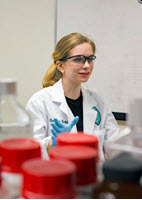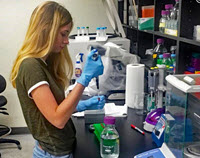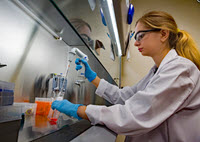
Oil contains thousands of different compounds that each affect the environment and living organisms differently. While some compounds have been well-studied, there are exponentially more that have not. Rebecca Lichtler conducts toxicity, gene expression, and gene mutation studies on oil-exposed mammal cells to determine if and how different oil compounds affect cell health.
Rebecca is a Ph.D. student with Tulane University’s School of Public Health and Tropical Medicine and a GoMRI Scholar with the project Toxicological Properties of Specific Aromatic Hydrocarbons Isolated from Fresh and Aged Crude Oil from the Deepwater Horizon Spill.
Her Path
Rebecca’s parents are scientists who sparked her early curiosity about scientific research. She began her journey as an undergraduate student at Tulane University studying cell and molecular biology, but felt like something was missing. Hoping to get involved in science that had a deeper connection to human health, she switched to the university’s public health program and changed her minor to cell and molecular biology. During a foundations course in environmental health, Rebecca met Dr. Jeffrey Wickliffe and took an undergraduate research position in his lab. As she neared graduation, Wickliffe invited her to apply for a doctoral student position in his lab conducting GoMRI-funded research, which she did after entering the School of Public Health’s environmental health sciences program.
“Of all the undergraduates that I’ve had experience with, Rebecca was far and away the most dedicated,” recalls Wickliffe. “I don’t think this department has ever had a Ph.D. student come straight out of an undergraduate program, but she’s probably one of the top Ph.D. students we have in the department right now. It has set the bar so that other [professors] might be less averse to taking on Ph.D. students coming directly from undergraduate studies.”
Her Work

Rebecca conducts oil exposure experiments on mouse lung cells, which represent a common route of exposure (respiration), and on liver cells, the organ most associated with metabolizing toxic chemicals. She uses three methods to analyze different polycyclic aromatic hydrocarbons (PAHs) and determine the most effective and efficient techniques for quantifying toxicity. “We’re trying find a balance between convenience and accuracy. Convenience is important because we get the information in a reasonable amount of time for a reasonable amount of money, but we also need that information to be as reliable and detailed as possible,” said Rebecca. “If an oil spill happens we can take a sample of the oil, break down the compounds, and know which ones are the most toxic that we need to worry about.”
The first approach uses a cytotoxicity test to determine how different compounds affect the cells’ ability to grow and survive after exposure. She exposes the cells to individual compounds for 6 hours followed by a 72-hour recovery period. Then she treats the cells with a pink fluorescent dye (sulforhodamine B) and uses a spectrophotometer to determine the amount of fluorescence. The proportion of color corresponds to healthy cells, which will have more color than cells whose growth was slowed or stopped by PAH exposure. She compares results between treatments to determine each tested compound’s relative toxicity.

The second approach uses a gene expression test to measure toxicity. Certain genes that metabolize toxic compounds (CYP1A1 and CYP1B1) are known to be upregulated, or more expressed, when cells are exposed to PAHs. Rebecca isolates the cells’ RNA (the expressed part of the DNA) and uses quantitative polymerase chain reaction to detect if CYP1A1 and CYP1B1 expression is increased after PAH exposure, which would indicate that exposure was significant enough to trigger the upregulation.
The third method involves genetic mutation assays, which require that cells recover for one week after exposure to allow mutations to become apparent. Lipids and proteins that appear on the cell surface make up the cells’ membrane. However, if the gene producing that protein is mutated, the proteins will not appear. Rebecca treats exposed cells with antibodies that “stain” protein markers and make them detectable using a flow cytometer. The more cells that lack a protein marker, the more mutagenic effects the PAH compound had on the cells. She plans to compare these results to the cytotoxicity results to determine if the number of mutations correlate with the growth inhibitions observed in her cytotoxicity studies.
The mutation assays are still in their early stages, but Rebecca is already seeing interesting results. The cytotoxicity experiments revealed a wide variation of toxicity and identified the oil compounds with a greater toxic effect than other compounds. However, the gene expression tests did not show those significant differences in toxicity. “The degree of upregulation does not significantly vary between compounds, regardless of their toxicity,” explained Rebecca. “This suggests that the gene expression test may not be a useful tool to determine the extent of toxicity.”
Rebecca hopes that her research will help identify which compounds will have the most significant human health impacts. “Being in New Orleans surrounded by so many people that are involved with the Gulf day-to-day and meeting people whose lives were affected after the spill has shown me how important this work is to people’s everyday lives,” she said. “It’s the whole reason I got into this field and makes my work really gratifying.”
Her Learning
One of Rebecca’s most valuable experiences working in Wickliffe’s lab has been to expand her own learning by teaching others. Their lab often includes inexperienced undergraduate researchers, and Rebecca finds that teaching them forces her to confront her own understanding of the techniques and conceptual framework. “If you can’t answer someone else’s question, then you don’t know it well enough yourself,” she said. “For me, the most helpful way of learning is actually teaching!”
Her Future
Rebecca hopes to continue working in research, perhaps in a post-doc position, and eventually become a professor with her own lab. She says that students interested in a scientific career should get involved in labs as early as possible. “A lot of students think that they have to work in a lab for free just to get any experience, but there are many supported positions available, even if it’s not in your dream field,” she said. “I’ve learned something from every lab I’ve been in even if it didn’t necessarily have to do with environmental health, whether it’s a technique or a way of thinking or a concept. Don’t stress if it’s not your dream topic – you’re going to learn something.”
Praise for Rebecca
Dr. Wickliffe describes Rebecca as a talented researcher who is able to quickly master difficult methods and protocols, pays attention to detail, and fosters a solid understanding of experimental design. “She knows when to use positive and negative controls, and she’s not averse to repeating experiments to verify and validate her findings.” He also praised her collaborative skills, highlighting her ability to offer constructive feedback to others while absorbing and valuing others’ opinions about her own work.
Dr. Charles Miller, the project’s principal investigator, describes her as one of their department’s most promising students, noting her strong work ethic such as working on a task before it has been assigned and eagerly accepting new ones. “She has a mix of the right personality traits to be a good scientist. I’ve seen her progress in learning to think critically about problems, ask the right questions, and formulate a plan to approach those questions,” he said. “People with all the right signs come along every now and then, and it’s like a nugget of gold when you find one. Anybody would be lucky to have her working in their lab.”
The GoMRI community embraces bright and dedicated students like Rebecca Lichtler and their important contributions. The GoMRI Scholars Program recognizes graduate students whose work focuses on GoMRI-funded projects and builds community for the next generation of ocean science professionals.
************
The Gulf of Mexico Research Initiative (GoMRI) is a 10-year independent research program established to study the effect, and the potential associated impact, of hydrocarbon releases on the environment and public health, as well as to develop improved spill mitigation, oil detection, characterization and remediation technologies. An independent and academic 20-member Research Board makes the funding and research direction decisions to ensure the intellectual quality, effectiveness and academic independence of the GoMRI research. All research data, findings and publications will be made publicly available. The program was established through a $500 million financial commitment from BP. For more information, visit https://gulfresearchinitiative.org/.
© Copyright 2010-2018 Gulf of Mexico Research Initiative (GoMRI) – All Rights Reserved. Redistribution is encouraged with acknowledgement to the Gulf of Mexico Research Initiative (GoMRI). Please credit images and/or videos as done in each article. Questions? Contact web-content editor Nilde “Maggie” Dannreuther, Northern Gulf Institute, Mississippi State University (maggied@ngi.msstate.edu).
